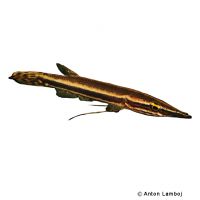Giant Pikehead (Luciocephalus pulcher)
| Giant Pikehead Luciocephalus pulcher | |
|---|---|
| Name | Giant Pikehead |
| Name Lat. | Luciocephalus pulcher |
| Synonym | Diplopterus pulcher |
| Family | Gouramies |
| Family lat. | Osphronemidae |
| Order | Labyrinth Fishes |
| Order lat. | Anabantiformes |
| Origin | Southeast Asia |
| Habitat | Forest streams, swamps |
| Diet | Piscivore |
| pH | 4.8-5.5 |
| Behavior | Predatory |
| Keeping | Group |
| Care Level | Experts only |
| Reproduction | Mouthbrooder |
| Breeding | Moderately difficult |
| Life Span | 5-8 years |
| Protection | No |
| Metric Units | |
| Size | 18 cm |
| Temperature | 22-26 °C |
| Hardness | 1-10 °dH |
| Aquarium | ~ 300 l |
| US Units | |
| Size | 7" |
| Temperature | 72-79 °F |
| Hardness | 18-178 ppm |
| Aquarium | ~ 80 gal |
Distribution and habitat
The range of the pikeheads is the south of the Malay Peninsula and parts of the Malay Archipelago (Sumatra, Borneo and some smaller neighboring islands). There they live in shady, slow-flowing streams in the rainforest, floodplains and swamps with lots of dead wood.
Maintenance
The aquarium should have dense planting with many roots as hiding places. A dark substrate with peat and foliage (sea almond leaves) as well as subdued light (floating plant cover) and extremely acidic water is ideal.
No ammonia, ammonium and nitrite should be detectable, the nitrate value should not exceed 100 mg/l. To ensure the water quality and oxygen content, a filter and heater adapted to the aquarium size is required, as well as lighting for the species-appropriate day-night rhythm of the animals.
Diet
These diurnal ambush predators feed mainly on live fish. The prey animal is put over the wide open, folded mouth (no sucking in!). The food supply consists of live fish, such as viviparous toothcarps, zebra danios, etc., as well as shrimp and insect larvae.
Only feed as much as will be eaten within a few minutes. A regular and varied diet promotes health and increases resistance
Behaviour and compatibility
They are well tolerated among themselves and should be kept in small groups of at least 5 animals. Only during the spawning season they behave territorial and defend their territory. Socialization is only possible with fish of at least the same size, which are not considered prey.
In principle, only mutually compatible fish species with similar demands on water quality and water temperature may be socialized.
Sex dimorphism
The sexes are difficult to distinguish; only with the onset of spawning does the female become recognizable by the fullness of her body. In dominant and courting males the stripe pattern breaks up into rows of dots.
Reproduction and breeding
The mouth brooding is done by the male. It courts with distended throat and opposite movements of the ventral fins. Mating takes place on the ground. The egg package deposited by the female, which may contain over 150 eggs, is picked up by the male in his throat sac for further mouthbrood care. After about 4 weeks, the 12-13 mm fry are released from the mouth.
Breeding is best accomplished with the larvae and later fry of various labyrinth fish.
Important
They have an additional respiratory organ, the so-called labyrinth (suprabranchial organ) with which they breathe atmospheric air and can suffocate if this is not possible. The air temperature in the breathing area must not be below the water temperature!
Pike heads are susceptible to bacterial and mycological diseases. Best results are achieved with soft, acidic water filtered through peat, with a low bacterial content.
The well-being of the fish should be checked regularly. Temperature should be checked daily, pH, hardness and nitrate levels should be checked at least every 14 days. Regular partial water changes are recommended, even if the contaminant level has not yet reached the upper limit. Sudden changes in water quality should be avoided. Newly introduced fish must be accustomed slowly to the water in the aquarium.
Further literature can be found in your pet store.
References
Text: petdata; Image: Anton Lamboj
Source: BMELV (1998): Tierschutzgutachten - Haltung von Zierfischen (Süßwasser); RIEHL & BAENSCH (2006): Aquarien Atlas Bd. 1, Mergus Verlag; ENGELMANN (2005): Zootierhaltung - Tiere in menschlicher Obhut: Fische, Verlag Harri Deutsch
- Gemäß § 21 Abs. 5 Tierschutzgesetz idgF
